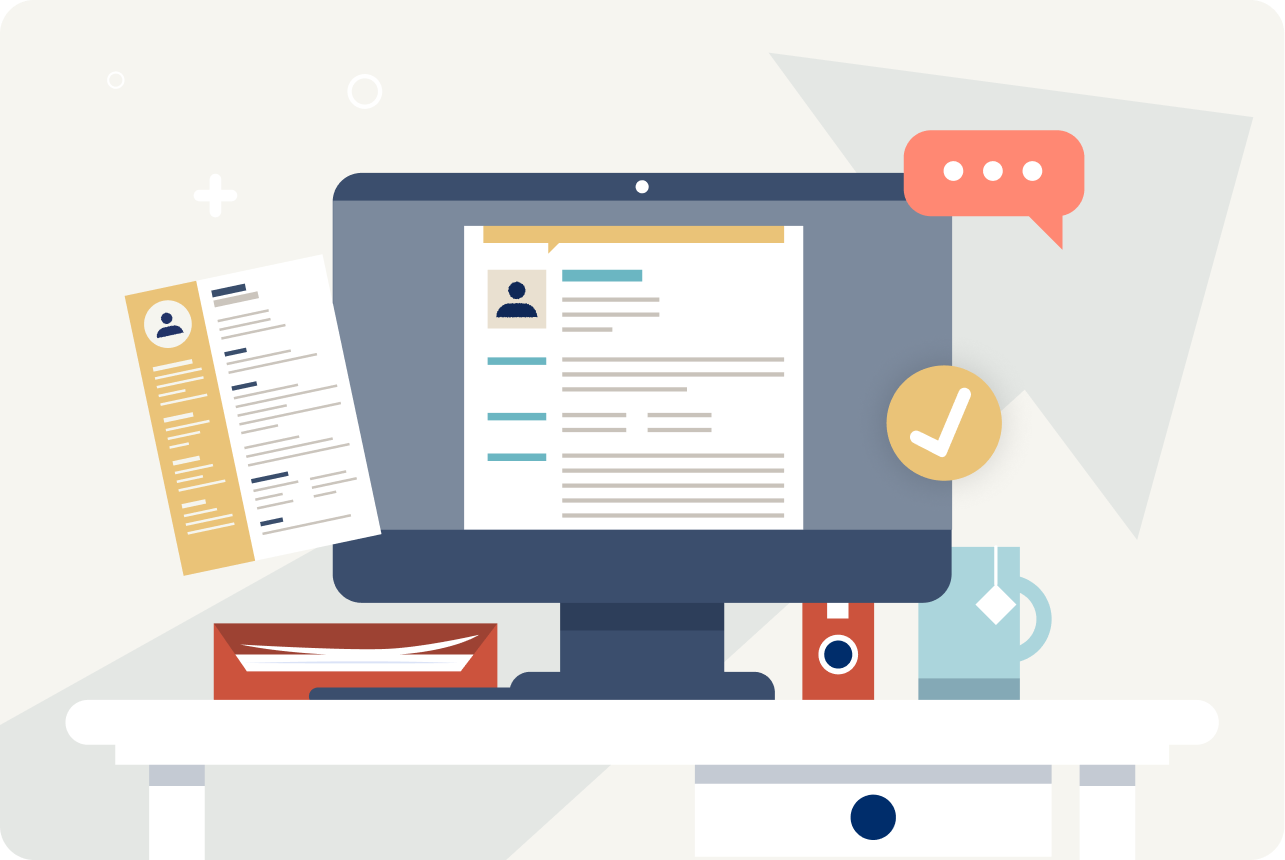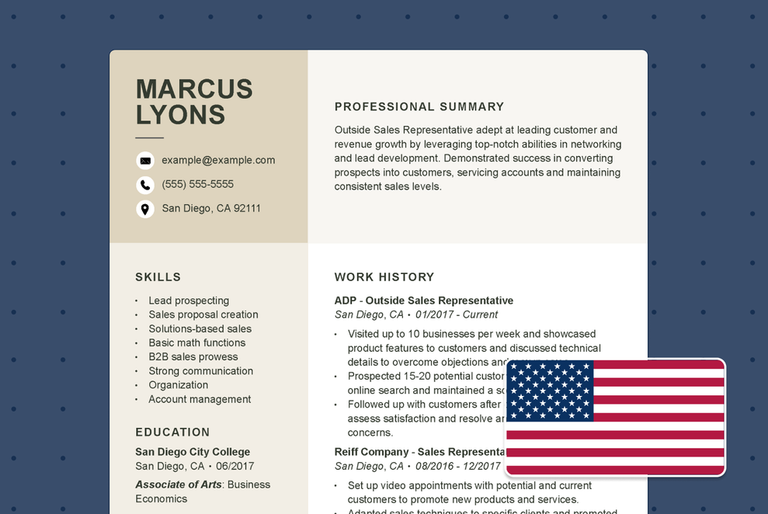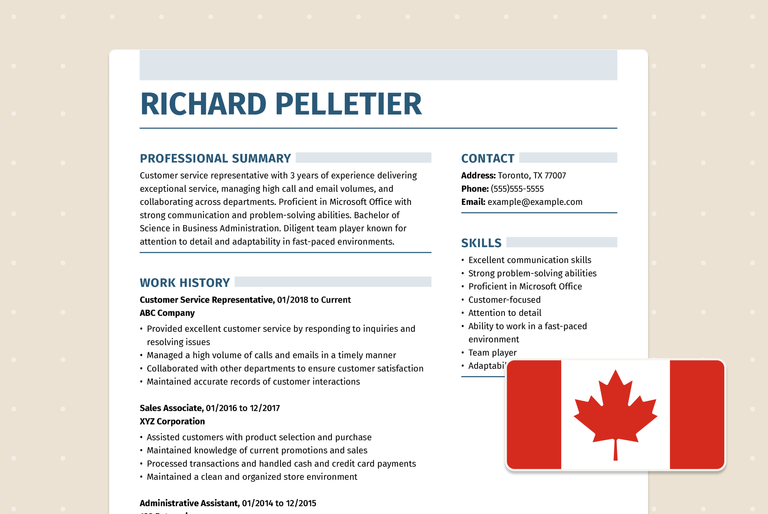Expert Resume Tips to Help You Land Your Dream Job

Our customers have been hired at: *Foot Note
A standout resume is essential in today’s competitive job market. Our Certified Professional Resume Writers are here to help with the best resume tips to impress recruiters and get hired faster.
Whether you are a recent graduate, a career changer or a seasoned professional, our expert tips and tricks will take the guesswork out of writing the perfect resume.
Explore the resume advice on this page and use our professional Resume Builder to start crafting a job application that wins interviews.
Top 5 tips for writing a resume:
Resume writing tips
1. Write in the third person
Writing in the third person means speaking as if you are talking about someone else. For instance, “I created brand guidelines for 10 clients” instead of “I created brand guidelines for 10 clients.”
Using the third person gives your resume a more formal and professional tone and allows hiring managers to focus on your professional expertise objectively.
Many resume sections naturally lend themselves to third-person writing. Keeping the entire document in the third person ensures consistency in style and voice.
Take the wine sales representative resume below, for example. Notice the use of the third person throughout the professional summary and work history sections.
2. Customize your resume for the job
To increase your chances of getting an interview, tailor your resume to the position you are applying for by aligning it with the job description and company culture.
Start by reading the job description carefully to identify the key skills and experience the employer is seeking.
Then, match your relevant qualifications to the job’s requirements and adjust the language and tone of your resume to reflect the company’s values and industry standards.
When you include relevant information that matches your job description, you’ll be more likely to get an interview and land the job you want.
3. Focus on accomplishments
One of our top tips on how to write a perfect resume is to showcase professional accomplishments in your resume work history section rather than listing basic job duties.
Highlighting your accomplishments demonstrates your impact on previous employers and shows hiring managers your capabilities.
Here is an example of how a registered nurse might showcase accomplishments throughout various sections of their resume.
In your resume summary
In the sample resume summary below, the job seeker notes accomplishments such as successfully implementing patient care protocol.
Dedicated and experienced Registered Nurse with over 5 years of clinical experience in a fast-paced hospital setting. Successfully implemented a new patient care protocol that resulted in a 20% decrease in patient readmission rates. Skilled in providing compassionate and evidence-based patient care while maintaining high professionalism and efficiency. Proficient in managing a diverse caseload and collaborating with interdisciplinary teams to ensure optimal patient outcomes.
In the work history section
The following resume work history section features relevant accomplishments in past roles, such as collaborating with a cross-functional team to decrease readmission rates.
WORK HISTORY
Registered Nurse
Massachusetts General Hospital | Boston, MA
June 2018 – Present
- Administered medications to an average of 30 patients per shift, ensuring accurate dosages and timely delivery
- Collaborated with a multidisciplinary team to develop and implement care plans for 50+ patients, resulting in a 15% decrease in hospital readmission rates.
- Conducted assessments and provided direct patient care for a caseload of 40+ individuals, achieving a patient satisfaction rating of 95%.
In the skills section
In this sample resume skills section, the job seeker contextualizes each skill with a related accomplishment.
SKILLS
- Patient Assessment: Conducted thorough assessments on 20+ patients daily, leading to accurate diagnoses and timely interventions.
- Medication Administration: Administered medications to 30+ patients per shift with a 100% accuracy rate.
- Care Planning: Developed and implemented individualized care plans for 50+ patients, improving patient outcomes and satisfaction.
In your education section
You can incorporate accomplishments into your resume education section by listing honors, awards and notable projects.
EDUCATION
Bachelor of Science in Nursing (BSN) | XYZ University
- Graduated with a GPA of 3.8, ranking in the top 5% of the graduating class.
- Completed 500+ clinical hours in various healthcare settings, including hospitals and community clinics.
- Conducted a research project on patient outcomes, resulting in a 20-page thesis and presentation to faculty members.
4. Use strong action words
Strong resume action words can greatly impact how recruiters and hiring managers view your professional skills, work experience and educational background.
Action verbs portray a sense of success and initiative, creating a vivid image of your abilities and accomplishments.
Instead of passive language like “responsible for” or “involved in,” use power verbs like “achieved,” “implemented” and “spearheaded” to show your proactive attitude towards work.
5. Quantify your achievements
Numbers can significantly enhance your resume’s effectiveness by highlighting your achievements in a quantifiable manner.
By including specific numbers and metrics on your resume, you make your accomplishments more tangible and enhance the credibility of your achievements.
Quantifying your impact shows that you are results-oriented and have a track record of delivering tangible outcomes.
Whether by highlighting percentage increases, time saved or targets exceeded, effectively leveraging numbers can help you stand out in a competitive job market.
6. Proofread more than once
This might be the most crucial of all our resume tips because one typo can eliminate your resume from running, even if you check all the necessary boxes for the job.
Before hitting send, check your resume closely for grammatical errors and typos, formatting inconsistencies and factual inaccuracies.
Use our ATS Resume Checker to scan your resume for 30+ common errors and get instant optimization suggestions to improve your resume score.
Resume building tips
1. Use a resume template
A professionally designed resume template will save you time and make your resume look polished and professional, increasing your chances of being noticed by prospective employers.
A good resume tip for choosing a template is to look for a clean, easy-to-read and well-organized layout that effectively displays your skills and qualifications.
We have a wide variety of resume templates built by professional graphic designers, so you can find one that matches your stylistic preferences.
2. Review industry-specific examples
One of the top tips for the best resume is to browse resume examples tailored to your industry or job title.
Industry-specific resume examples provide insight into what employers in your industry expect to see in terms of skills, experiences and achievements.
They can help you understand the appropriate tone and professional language used in your field, ensuring your resume communicates effectively and professionally.
For example, take a look at the esthetician resume below. It uses a clean and impactful layout and showcases cosmetology skills and industry-specific work experience.
3. Craft multiple versions of your resume
Different jobs and industries often have unique requirements. By creating multiple versions of your resume, you can tailor each one to highlight the most relevant skills and qualifications.
By tailoring your resume to each job, you increase your chances of catching the attention of different employers, maximizing your opportunities for interviews and job offers.
Our Resume Builder can help you customize each section of your resume, streamlining the process of creating different versions of your resume and ensuring consistent formatting.
You can build and save an unlimited number of resumes and tailor each one to the specific job with ready-made content from Certified Professional Resume Writers.
4. Optimize for ATS screening
According to a recent study, 90% of Fortune 500 companies use applicant tracking systems (ATS) to screen resumes, so making an ATS-friendly resume is a must.
Employers use ATS software to screen and filter resumes based on keywords and formatting parameters.
It's important to ensure your resume is ATS-friendly to ensure it makes it past the first screening stage. Here are a few tips for a good resume that passes ATS and impresses recruiters:
- Use standard formatting: Use a clean and simple layout and avoid tables, text boxes, graphics or images. Use standard fonts like Arial, Times New Roman or Calibri.
- Include relevant keywords: Carefully read the job description and include relevant keywords and phrases. Include variations of keywords to cover all possible matches.
- Use standard section headings: Use common headings such as "Work Experience," "Education," "Skills" and "Certifications."
- Save in the right format: Your resume should be saved as a .docx or .pdf file, as these formats are commonly accepted by ATS. Check the job posting for requirements.
- Avoid special characters: Use standard bullet points instead of special symbols or icons. Avoid using special characters or symbols that may not be recognized by the ATS.
- Use proper dates and locations: Clearly list the dates of employment and locations for each job using the standard format (e.g., "January 2020 – Present" and "Boston, MA").
- Avoid headers and footers: Important information should not be placed in headers or footers, as they may not be parsed correctly by ATS.
Resume formatting tips
1. Choose the best format for your resume
Choosing the right resume format for your resume is important because it will help you present your skills and experience in the best way possible.
The best resume format for you depends on the industry you’re applying for and the job requirements you’re looking for. The three most widely used resume formats are:
2. Follow formatting best practices
Proper formatting is one of the best resume tips because a well-formatted resume is visually appealing and easier for recruiters and hiring managers to read.
A clear and organized resume demonstrates organizational skills and professionalism, creating a great first impression and increasing your chance of getting a job interview.
Here are a few formatting conventions to keep in mind while you craft your resume:
- Margins and spacing: For a balanced look, use 1-inch margins on all sides. Ensure adequate spacing between sections and entries for readability.
- Standard font: Use a standard resume font like Calibri or Helvetica. Font size should be 10-12 points for the body text and 14-16 points for headings.
- Clean layout: Use a simple, clean design with plenty of white space. Avoid overly complex designs or heavy use of graphics.
- Consistent formatting: Maintain consistent formatting throughout the document. Use the same font, font size and style for similar sections.
- Bullet points: Use bullet points to list job duties, achievements and skills. Keep bullet points concise and start each with an action verb.
- Align text properly: Align text to the left for readability. Avoid center or justified alignment which can create uneven spacing.
- Use of bold and italics: Use bold for job titles and company names to make them stand out. Use italics sparingly, such as for dates or locations.
3. Stick to one or two pages
Eye tracking studies show that recruiters spend seven seconds looking at a resume — that’s not a lot of time, so having a succinct resume is crucial to your success.
A one-page resume is more likely to grab their attention quickly and demonstrates your ability to prioritize information and keep it relevant.
A concise resume helps ensure that your most significant achievements stand out, rather than being buried in a longer document.
A two-page resume is also acceptable for professionals with over ten years of relevant experience.
Whether you use one or two pages, ensure that every piece of information adds value and helps make the case for why you are the best candidate for the job.
4. Download in the required format
It’s generally recommended to download and submit your resume in PDF file format unless otherwise specified in the job description.
A PDF file will preserve your resume’s formatting exactly as you set it up, regardless of the device or software the employer uses to open it.
However, some older or less advanced Applicant Tracking Systems (ATS) handle Word files better, as they can more easily read and parse the text.
If you're unsure which file format to submit your resume in, contact the recruiter or potential employer or scan the job description details.
Make a resume with MyPerfectResume
Our Resume builder can help you write the perfect resume. Start Now!
- Start with a functional resume template to emphasize the hard skills and soft skills you’ve developed through your coursework or part-time work.
- Include a resume objective instead of a professional summary to give employers or college administrators a crystal clear idea of why you’re applying for their job or school.
- In your work history section, include any relevant experience from part-time or summer jobs, volunteer experiences, extracurricular activities or school projects.
- Review high school resume examples for ideas on how to craft a great high school resume.
- Focus on scholastic or community achievements like awards, classroom or extracurricular leadership roles or successful projects.
- Highlight your transferable skills, such as teamwork, adaptability and problem-solving.
See our high school graduate resume templates if you recently graduated. You'll get expertly crafted samples and actionable tips to stand out.
- Highlight internships, part-time or summer jobs, volunteer work, community service and extracurricular activities.
- Bring your education to the forefront by placing it just below your career objective. See our student resume examples to get inspired.
- Describe your relevant coursework and special projects in your education section. Focus on academic awards, scholarships and classroom or internship achievements.
- Consider adding a “Key Qualifications” section above your skills section to spotlight your technical skills or relevant transferable skills.
To make the most of your job search, consider these resume tips if you are an experienced professional:
- Consider using the combination or hybrid resume format to showcase your depth of knowledge in your field alongside your vast skill set.
- Emphasize your adaptability and willingness to learn as key strengths in your professional summary and skills section.
- Include recent training or certifications pertinent to the job you are applying for.
- Emphasize your accomplishments in previous roles.
- Limit your work history to the last 10 to 15 years to keep your resume concise and your experience relevant.
Here are some good resume tips if you’re changing careers:
- Use an objective statement instead of a resume summary to explain your career change motivations. For example, "Transitioning professionals with a background in marketing and a passion for data analytics. Skilled in project management and adept at adapting to new industries. Seeking to leverage strong communication skills and analytical mindset in a new role in data science.”
- Consider using the functional resume format to emphasize your skills over chronological work history, or write a combination resume to showcase relevant work achievements with your skills.
- Emphasize your transferable skills such as problem-solving skills and adaptability, along with relevant technical skills.
- Create a certification or training section under any additional training or certifications related to your new career path for added credibility.
- Tailor your work history section to focus only on experiences and accomplishments that align with the new role's requirements.
Key takeaways
- Customize your resume for each job application, aligning your skills and experiences with the specific requirements of the job.
- Whenever possible, use numbers to quantify your accomplishments to provide concrete evidence of your capabilities and make your achievements more tangible.
- Limit your resume to one or two pages. Only include information that is relevant to the job you are applying for.
- Use a clean, professional layout with clear headings, bullet points and consistent font use to ensure that key information is easily accessible.
- Always proofread your resume multiple times for grammatical errors and typos. Consider getting a second set of eyes on it before submitting.
FAQ
How long should my resume be?
Your resume should ideally be one page long, but it can extend to two pages if you have extensive relevant experience and skills.
Keeping your resume concise ensures that recruiters and hiring managers can quickly scan your qualifications.
See our guide on how long a resume should be for tips on the ideal resume length for your career stage.
What is the best resume format to use?
Your best resume format will depend on your professional experience, goals and skills.
For example, if you have no work experience, a functional resume is a good bet because it will highlight your skills.
However, if you have at least one year of experience, a chronological resume will show potential employers what you have done in the past so they can gauge your potential as their employee.
See what a resume should look like for design and layout tips from career advice experts. You can explore our resume guidance for people with disabilities for tips tailored to you if you are a person with a disability.
Should I include a summary or objective on my resume?
We recommend a resume objective if you are applying for your first job or changing careers. It allows you to explain why you want the job and why you are the best candidate.
However, a professional summary is better if you have work-relevant experience because it provides a quick snapshot of your skills and experience.
Another option is to include a resume profile or resume About Me section that showcases your job-relevant skills and qualifications.
How important are keywords in a resume?
Keywords in a resume are crucial because they help your resume get noticed by Applicant Tracking Systems and into the hands of recruiters and hiring managers.
Tailoring your resume with relevant keywords from the job description can increase your chances of getting selected for an interview. Our Google resume examples demonstrate how you can tailor your resume for a specific employer.
Use industry-specific terms and skills to showcase your qualifications effectively, and only use keywords that match your skills and experience.
Is it necessary to tailor my resume for each job application?
Yes, it is important to customize your resume for each job application.
By aligning your skills and experiences with the job’s specific requirements, you can increase your chances of standing out to potential employers.
Tailoring your resume shows you are attentive to detail and genuinely interested in the position, making you a more competitive candidate.
If you are transitioning from a federal job to the private sector, we
How far back should a resume go?
Your resume should include relevant experience from the past 10 to 15 years. This range provides a comprehensive view of your professional journey while remaining relevant to the job.
For entry-level candidates, include all pertinent internships and part-time jobs, even if they extend beyond this timeframe, to showcase your skills and experiences.
Senior professionals should focus on roles that highlight leadership, relevant expertise and significant achievements, briefly summarizing older or less relevant positions.
Always tailor your resume to the position, emphasizing the experience that best aligns with the job requirements and effectively showcases your qualifications.
How do I make my resume stand out?
To make your resume stand out, start by ensuring it’s tailored specifically to each job you apply for, highlighting the skills and experiences that align closely with the job description.
Use a clean, professional layout with clear headings and a logical structure to make it easy for hiring managers to scan.
Quantify your achievements with specific numbers and results to demonstrate your impact in previous roles.
Make sure your resume is error-free with no typos or grammatical mistakes, as this reflects your attention to detail and professionalism.
Tailor your resume to the specific role and industry. For example, see how to transition from government resume to a private-sector resume, which exemplifies the importance of structuring your resume according to industry standards.
What should you leave out of a resume?
When crafting your resume, it’s crucial to omit certain details to maintain professionalism and relevancy.
Personal information such as your social security number, marital status, age, photo or religious affiliations should be left out unless specifically relevant to the job (such as in certain acting roles).
Avoid mentioning outdated skills, irrelevant work experiences or positions that don’t contribute to your current career goals. Additionally, steer clear of including salary history or reasons for leaving previous jobs, as these can be discussed during an interview if necessary.
Always skip overly personal details or hobbies unless they directly enhance your candidacy for the specific role. By keeping your resume focused and relevant, you ensure it’s a strong, professional representation of your qualifications.
Do I need to put all my work experience on my resume?
No, you do not need to include all your work experience on your resume. Instead, focus on including positions that are relevant to the job you are applying for or that demonstrate transferable skills applicable to the new role.
Tailoring your resume this way helps to keep it concise and focused, making it easier for employers to see your qualifications and fit for the position.
For older or less relevant roles, consider summarizing them briefly or omitting them altogether, especially if they do not contribute significantly to your current career objectives.
How we reviewed this article
Since 2012, we have helped more than 11 million job seekers. We want to make your career journey accessible and manageable through our services and Career Center’s how-to guides and tips. In our commitment to bring you a transparent process, we present our Editorial Process.
Sources
- Columbia University. Article. Optimizing Your Resume for Applicant Tracking Systems
- Laker, Benjamin, Pereira Vijay, Behl, Abhishek, Khan, Zaheer. Harvard Business Review. Article. Switching Careers? Here’s How to Write a Strong Resume.
- O’Donnell, Riia. HR Dive. Article. Eye tracking study shows recruiters look at resumes for 7 seconds
Our customers have been hired at:*Foot Note













